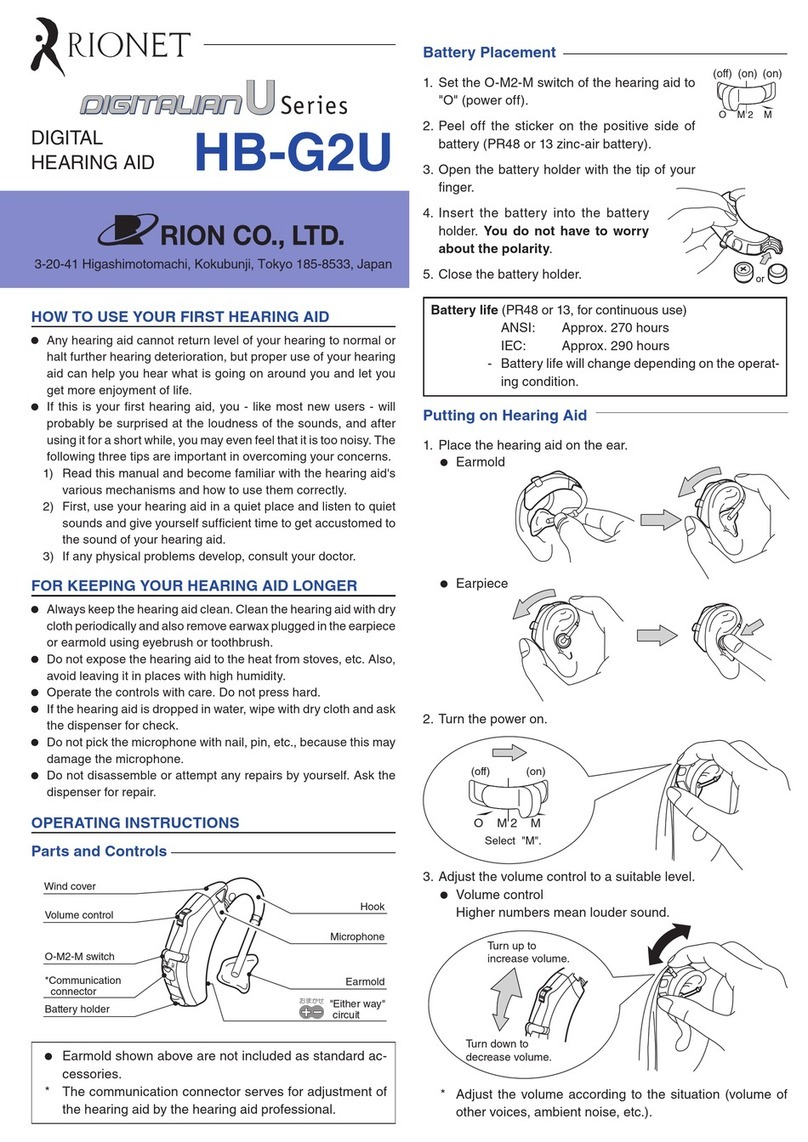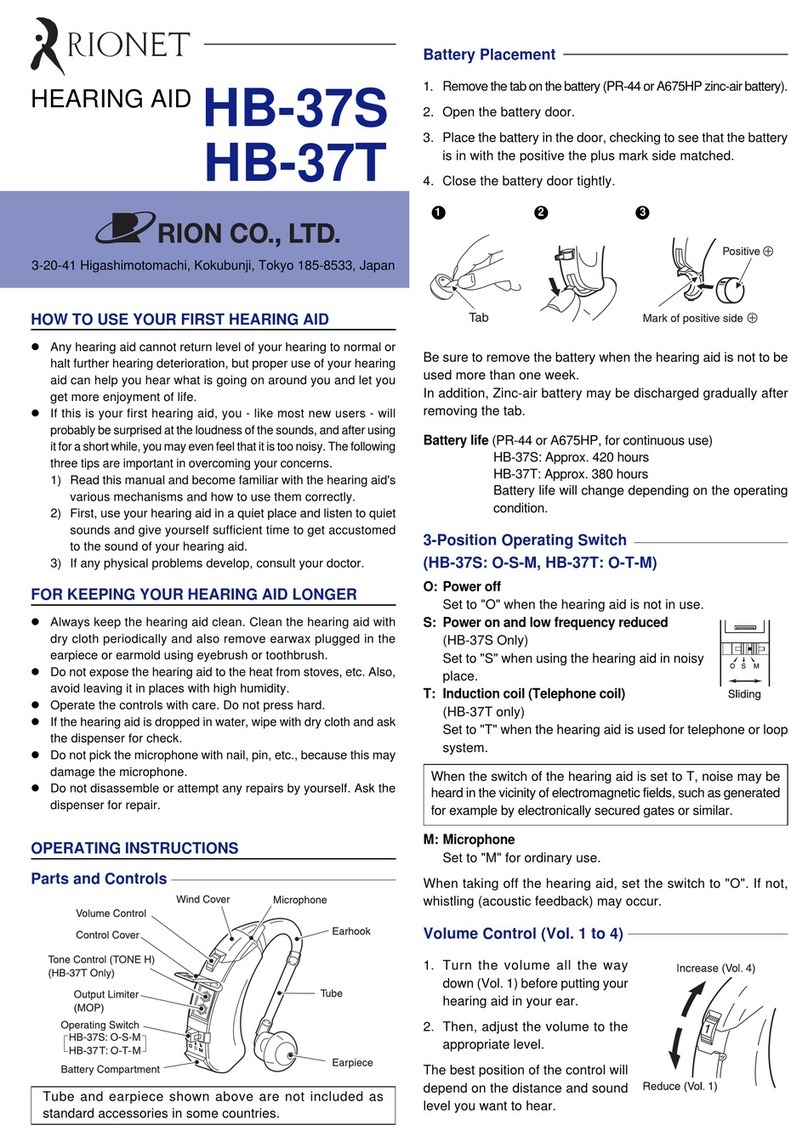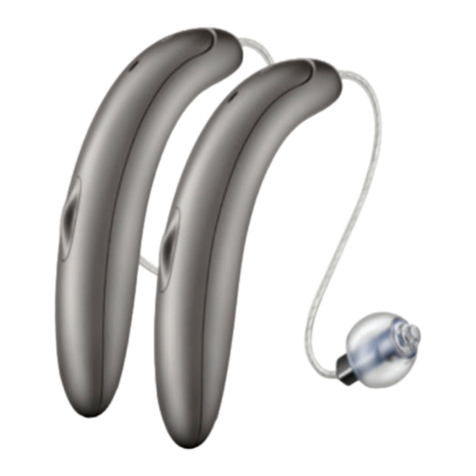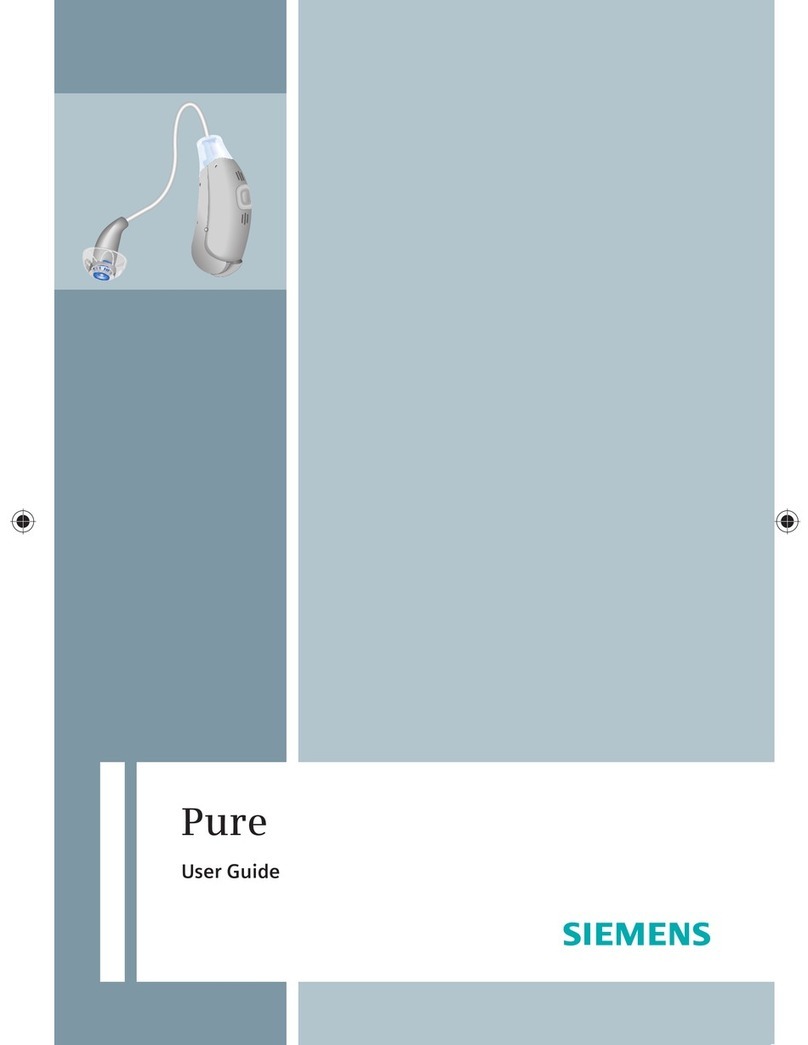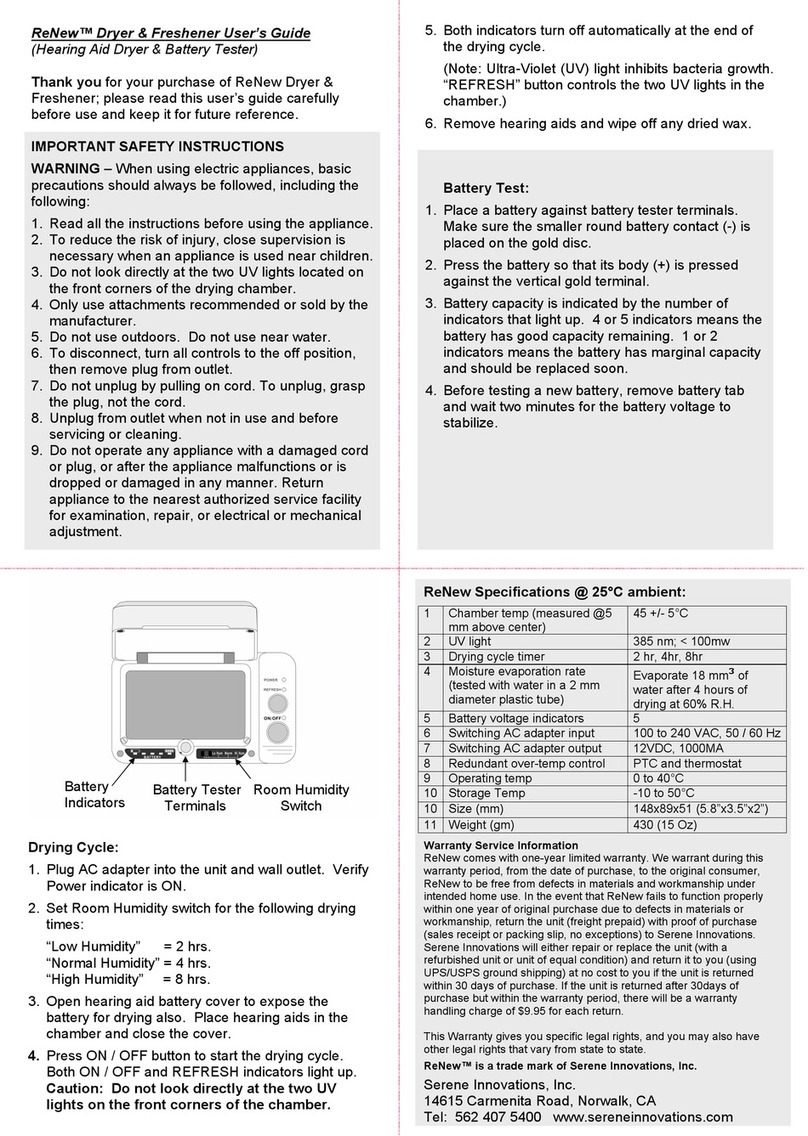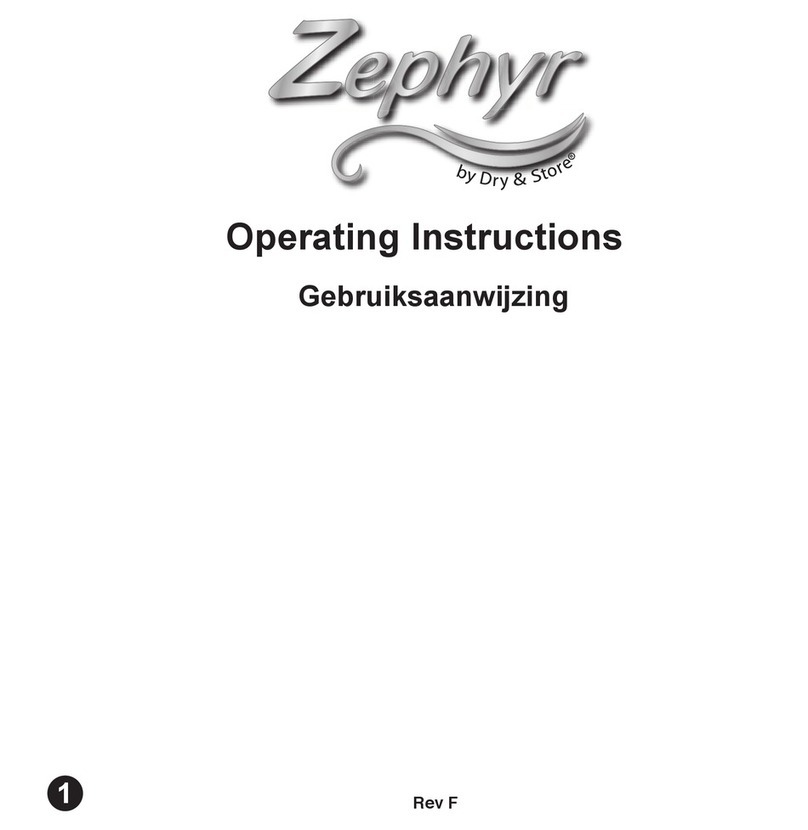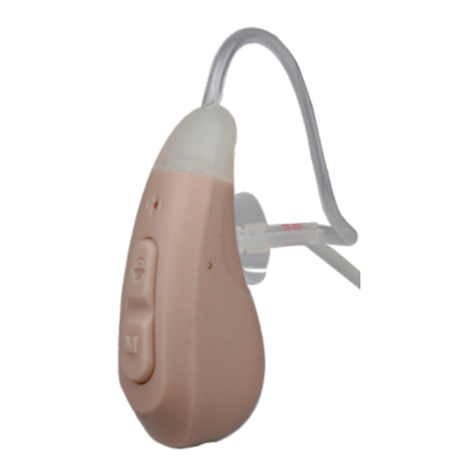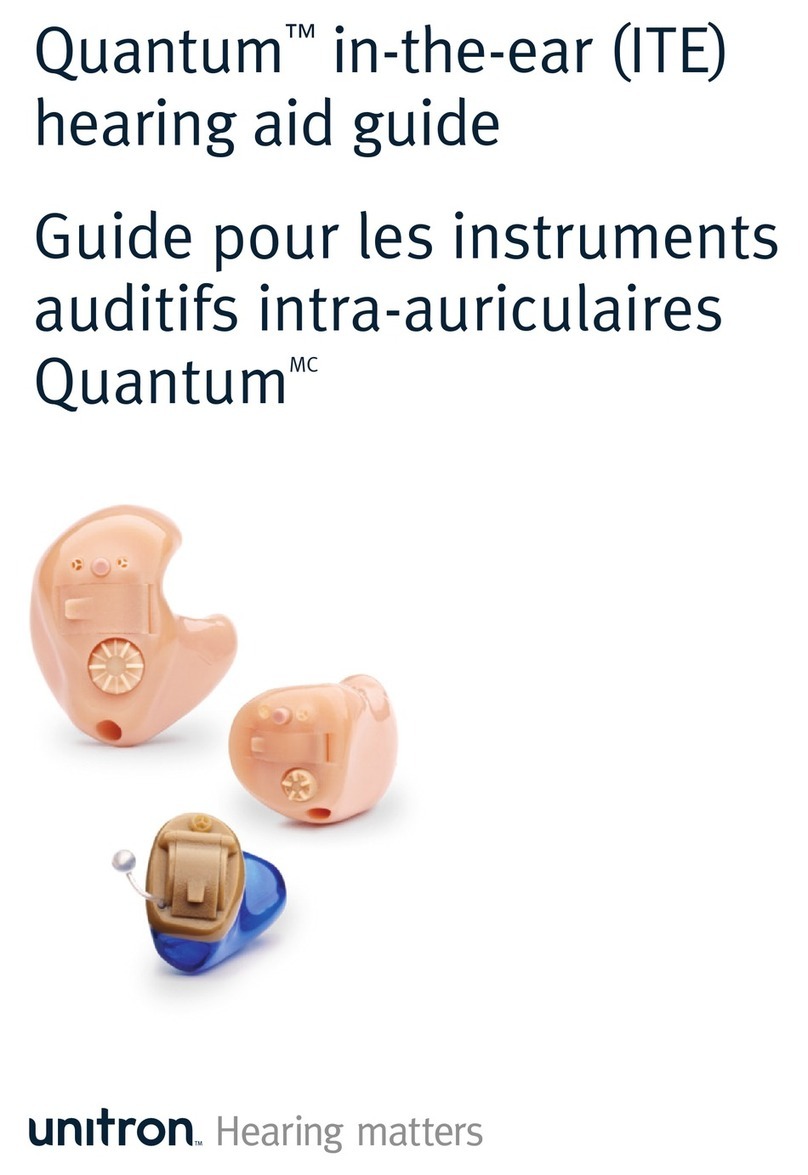rionet HB-G4P User manual

Earmold shown above are not included as standard ac-
cessories.
* The communication connector serves for adjustment of
the hearing aid by the hearing aid professional. Using
the optional Audio input Controller and dedicated cable,
external equipment can be connected directly to HB-G4P,
allowing the wearer to listen to the sound from various
devices.
Battery Placement
1. Set the O-MT-M switch of the hearing aid to
"O" (power off).
2. Peel off the sticker on the positive side of
battery (PR44 or 675 zinc-air battery).
3. Open the battery holder with the tip of your finger.
4. Insert a PR44 or 675 battery into the
battery holder with correct polarity;
the +/- mark on the battery and the
lid should be on the same side.
5. Close the battery holder.
Battery life (PR44 or 675, for continuous use)
Approx. 160 hours
- Battery life will change depending on the operat-
ing condition.
Putting on Hearing Aid
1. Place the hearing aid on the ear.
Earmold
HOW TO USE YOUR FIRST HEARING AID
Any hearing aid cannot return level of your hearing to normal or
halt further hearing deterioration, but proper use of your hearing
aid can help you hear what is going on around you and let you
get more enjoyment of life.
If this is your first hearing aid, you - like most new users - will
probably be surprised at the loudness of the sounds, and after
using it for a short while, you may even feel that it is too noisy. The
following three tips are important in overcoming your concerns.
1) Read this manual and become familiar with the hearing aid's
various mechanisms and how to use them correctly.
2) First, use your hearing aid in a quiet place and listen to quiet
sounds and give yourself sufficient time to get accustomed to
the sound of your hearing aid.
3) If any physical problems develop, consult your doctor.
FOR KEEPING YOUR HEARING AID LONGER
Always keep the hearing aid clean. Clean the hearing aid with dry
cloth periodically and also remove earwax plugged in the earpiece
or earmold using eyebrush or toothbrush.
Do not expose the hearing aid to the heat from stoves, etc. Also,
avoid leaving it in places with high humidity.
Operate the controls with care. Do not press hard.
If the hearing aid is dropped in water, wipe with dry cloth and ask
the dispenser for check.
Do not pick the microphone with nail, pin, etc., because this may
damage the microphone.
Do not disassemble or attempt any repairs by yourself. Ask the
dispenser for repair.
3-20-41 Higashimotomachi, Kokubunji, Tokyo 185-8533, Japan
HB-G4P
DIGITAL HEARING AID
(off) (on) (on)
O M T M
+/- mark
(off) (on)
Select "M".
O M T M
Turn up to
increase volume.
Turn down to
decrease volume.
Wind cover
Volume control
Control cover
O-MT-M switch
Communication/
Audio input connector
Battery holder
Earmold
+/- mark
Hook
Microphone
OPERATING INSTRUCTIONS
Parts and Controls
Earpiece
2. Turn the power on.
3. Adjust the volume control to a suitable level.
Volume control
Higher numbers mean louder sound.
* Adjust the volume according to the situation (volume of
other voices, ambient noise, etc.).

O-MT-M Switch
O: Hearing aid is turned off and no sound is heard.
MT: Sounds through both the microphone and telephone coil can
be heard. Set to "MT" position when using your hearing aid
for telephone or induction loop system in combination with
the MT balancer.
When the switch of the hearing aid is set to MT, noise may be
heard in the vicinity of electromagnetic fields, such as generated
for example by electronically secured gates or similar.
M: Microphone for ordinary use. This is the normal operating
position.
Removing Hearing Aid
1. Set the switch to "O" (power off) before re-
moving the hearing aid. If the switch is left in
the "M" or "MT" position, acoustic feedback
(high-pitched sounds) may occur.
2. Be sure to set the switch to "O" and take out the battery, when
not using the hearing aid.
Recycled papers are used for this manual.
No. 51310 06-12
Turn-on precaution
If you switch the hearing aid off and then immediately on again,
there may be no sound, but this is not a defect. In such a case,
return the switch to "O" (Off), wait for at least 10 seconds, and
then set the switch to "M" or "MT" again.
Adjusting the Controls
This hearing aid is a digital type. Any adjustments must be done
at the dealer. For details, please contact the dealer.
Factory default setting for communication/Audio input selector
The default setting is as shown at right.
FIT: Position for hearing aid fitting adjustment
: Position for Audio input
Other setting
O - MT - M switch: "O"
Volume control (1 to 4): "1"
140 0dB=20µPa 1600 2500
130
120
110
100
90
100 200 500 1000 2000 5000 10000
Frequency (Hz)
Output SPL (dB)
Input SPL 60dB
150 0dB=20µPa 1600 2500
140
130
120
110
100
100 200 500 1000 2000 5000 10000
Frequency (Hz)
Output SPL (dB)
Input SPL 90dB
0 dB
-19 dB
80 1600 2500
70
60
50
40
30
100 200 500 1000 2000 5000 10000
Input SPL 50dB
(0dB=20µPa)
Frequency (Hz)
Acoustic Gain (dB)
140 0dB=20µPa 1600 2500
130
120
110
100
90
100 200 500 1000 2000 5000 10000
Frequency (Hz)
Output SPL (dB)
Input SPL 60dB
150 0dB=20µPa 1600 2500
140
130
120
110
100
100 200 500 1000 2000 5000 10000
Frequency (Hz)
Output SPL (dB)
Input SPL 90dB
0 dB
-19 dB
80 1600 2500
70
60
50
40
30
100 200 500 1000 2000 5000 10000
Input SPL 50dB
(0dB=20µPa)
Frequency (Hz)
Acoustic Gain (dB)
(off) (on) (on)
O M T M
Full-on gain curve
Frequency response curve OSPL90 curve and effect of
output limiting control
Full-on acoustic gain
frequency response curve
Basic frequency response
curve
OSPL90 curve and effect
of output limiting control
Note:
(1) Production number (se-
rial number) is indicated at
the upper rear side of the
unit.
(2) Manufacturer's name is
imprinted at the lower rear
side of the unit.
TECHNICAL DATA (According to ANSI standard S3.22 2003)
Maximum-OSPL90 141 dB (850 Hz)
HFA-OSPL90 133 dB
HFA-full-on Acoustic
Gain 66 dB
Reference Test Gain 56 dB
Frequency Range 200 Hz to 5000 Hz
Equivalent Input Noise Level
25 dB
Total Harmonic Distor
tion
500 Hz: 4% 800 Hz:1% 1600 Hz: 2%
HFA-SPLIV 113 dB at 31.6 mA/m
AGC Input AGC / OPC (Output AGC)
Attack / Recovery Time
Input AGC
Attack / Recovery: 4 or 252 msec
Output AGC
Attack: 0.25 msec
Recovery: 0.25 or 32 msec
Operating Switch O-MT-M
Output Limiting Control OPC (range: 19 dB)
Gain Control Main VR (range: 16 dB)
GAIN (range: 19 dB)
Battery Type/Supply Voltage
675/1.3 V
Battery Current 2.7 mA
Battery Life Approx. 160 hours
Dimensions/Weight 4.67 × 1.62 × 0.97 cm /
6.7 g (excluding battery)
(Typical value with E0 hook)
TECHNICAL DATA ( )
Reference Test Frequency
1600 Hz
OSPL90 138 dB
500 Hz 137 dB
Peak 145 dB
Full-on Acoustic Gain 75 dB
Equivalent Input Noise Level
24 dB
Total Harmonic Distortion
500 Hz: 2% 800 Hz: 1% 1600 Hz:
2%
Induction Coil Sensitivity 105 dB at 1 mA/m
AGC Input AGC / OPC (Output AGC)
Attack / Recovery Time
Input AGC
Attack / Recovery: 4 or 252 msec
Output AGC
Attack: 0.25 msec
Recovery: 0.25 or 32 msec
Operating Switch O-MT-M
Output Limiting Control OPC (range: 19 dB)
Gain Control Main VR (range: 16 dB)
GAIN (range: 19 dB)
Battery Type/Supply Voltage
PR44/1.3 V
Battery Current 2.7 mA
Battery Life Approx. 160 hours
Dimensions/Weight 4.67 × 1.62 × 0.97 cm /
6.7 g (excluding battery)
(Typical value with E0 hook)
According to IEC standard Pub. 60118-0-1983
Amendment 1-1994
Table of contents
Other rionet Hearing Aid manuals
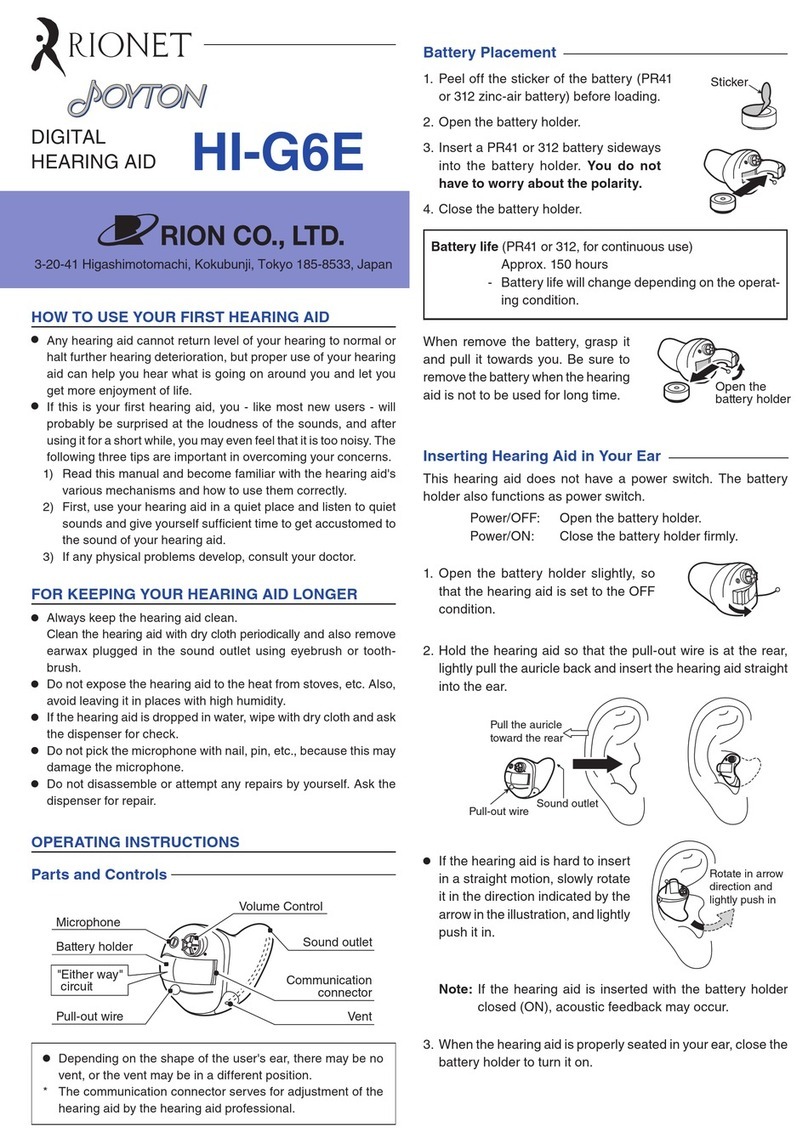
rionet
rionet Joyton HI-G6E User manual

rionet
rionet HB-G4PE User manual
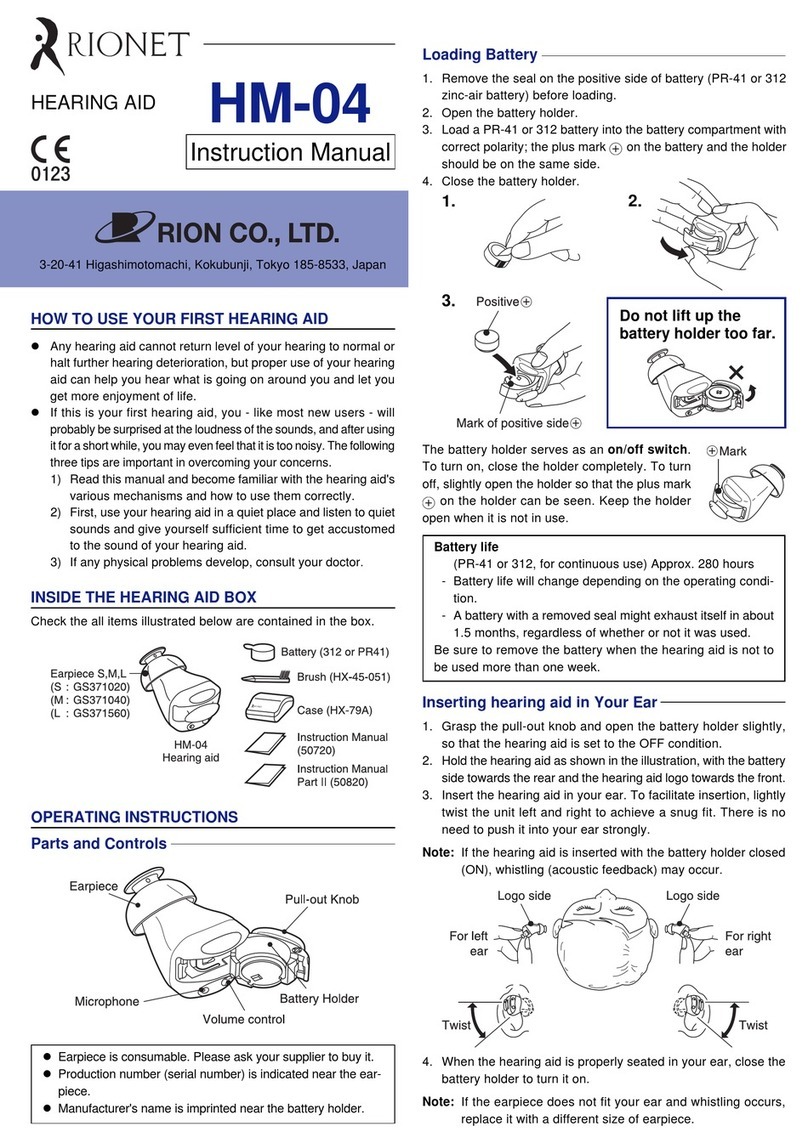
rionet
rionet HM-04 User manual
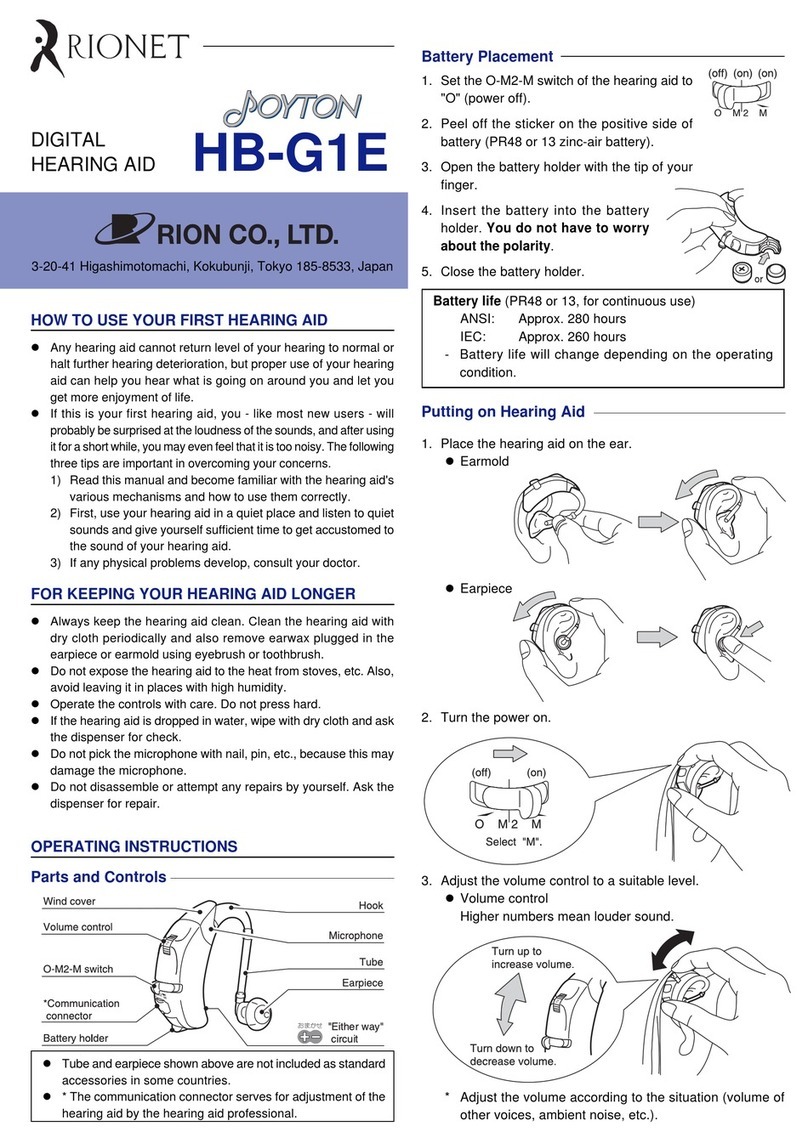
rionet
rionet Joyton HB-G1E User manual
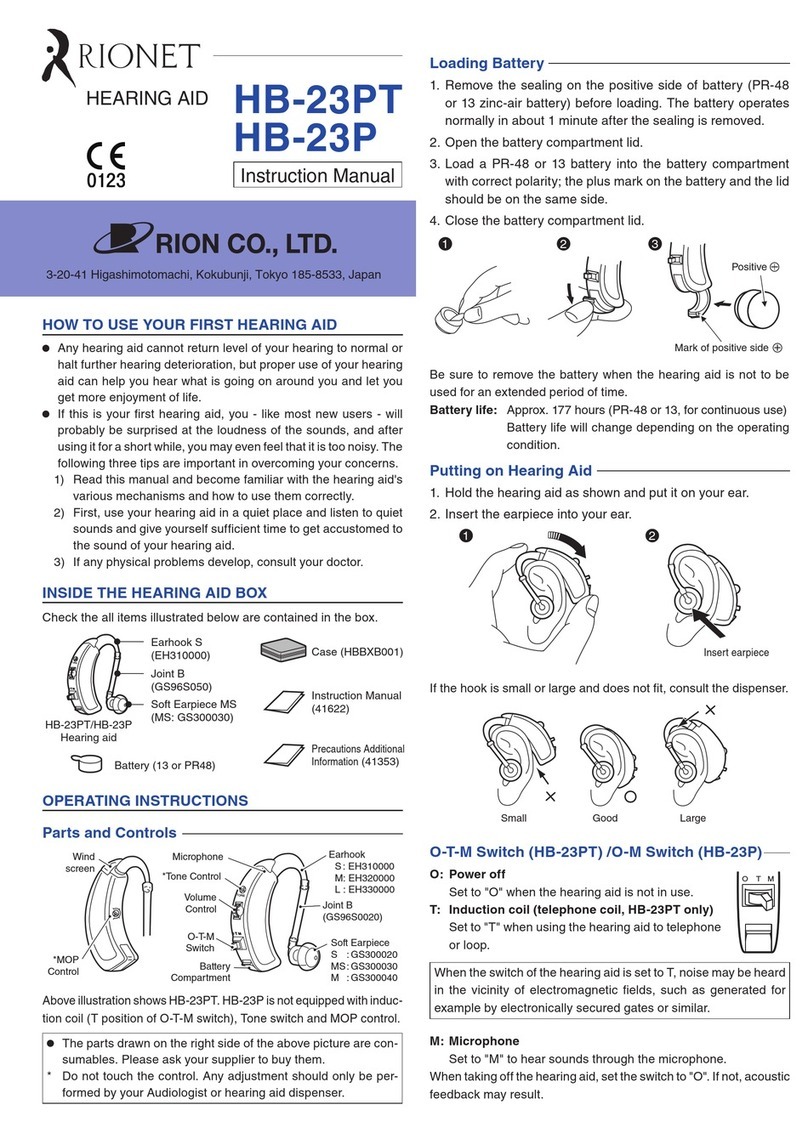
rionet
rionet HB-23PT User manual

rionet
rionet HI-G5R User manual
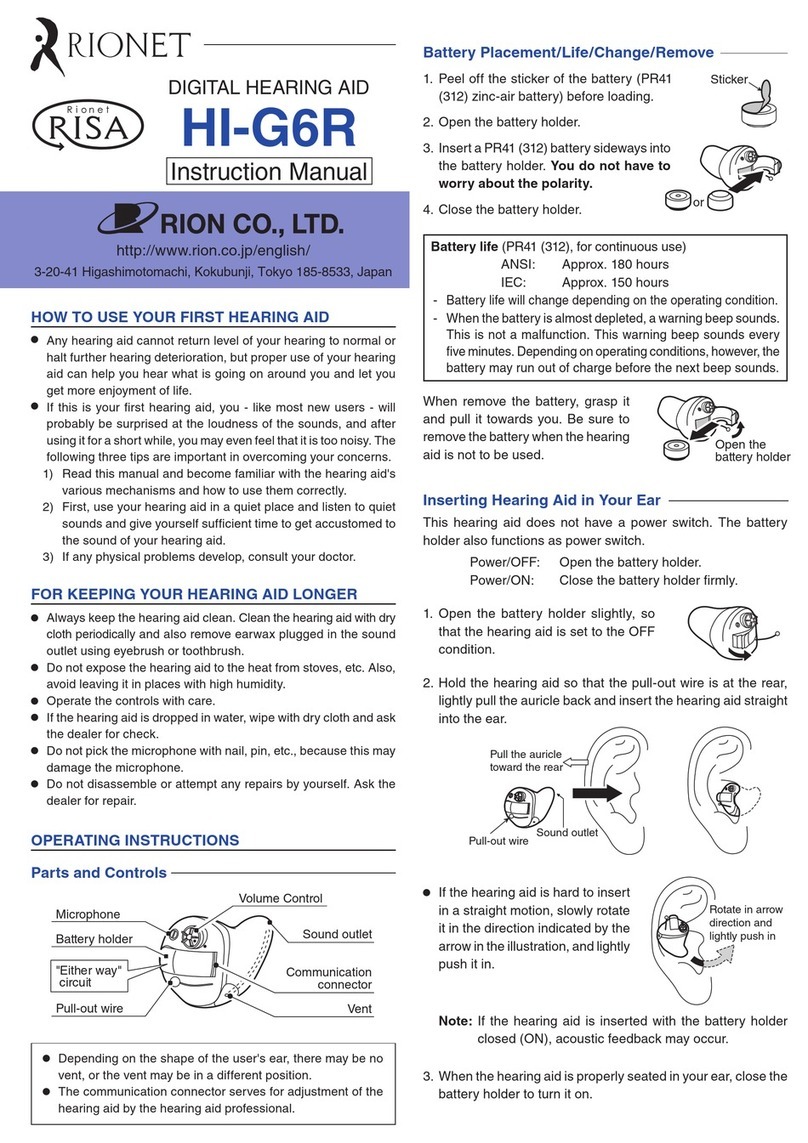
rionet
rionet HI-G6R User manual
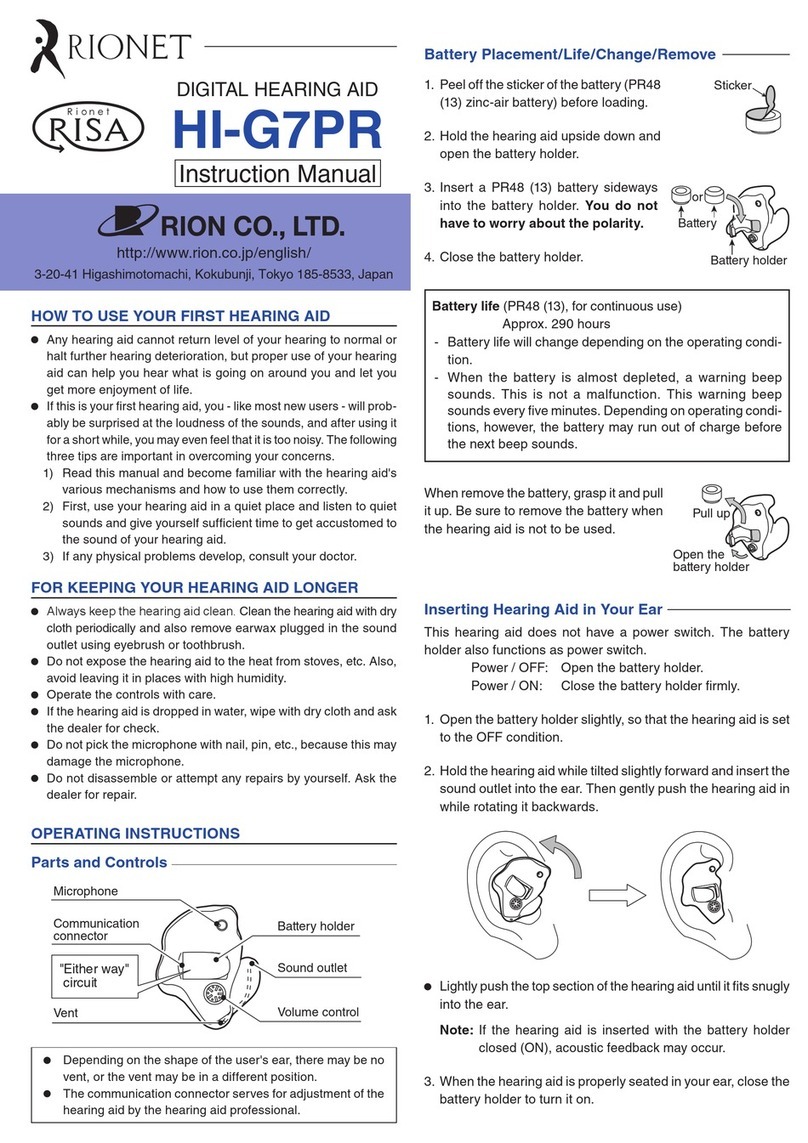
rionet
rionet RISA HI-G7PR User manual
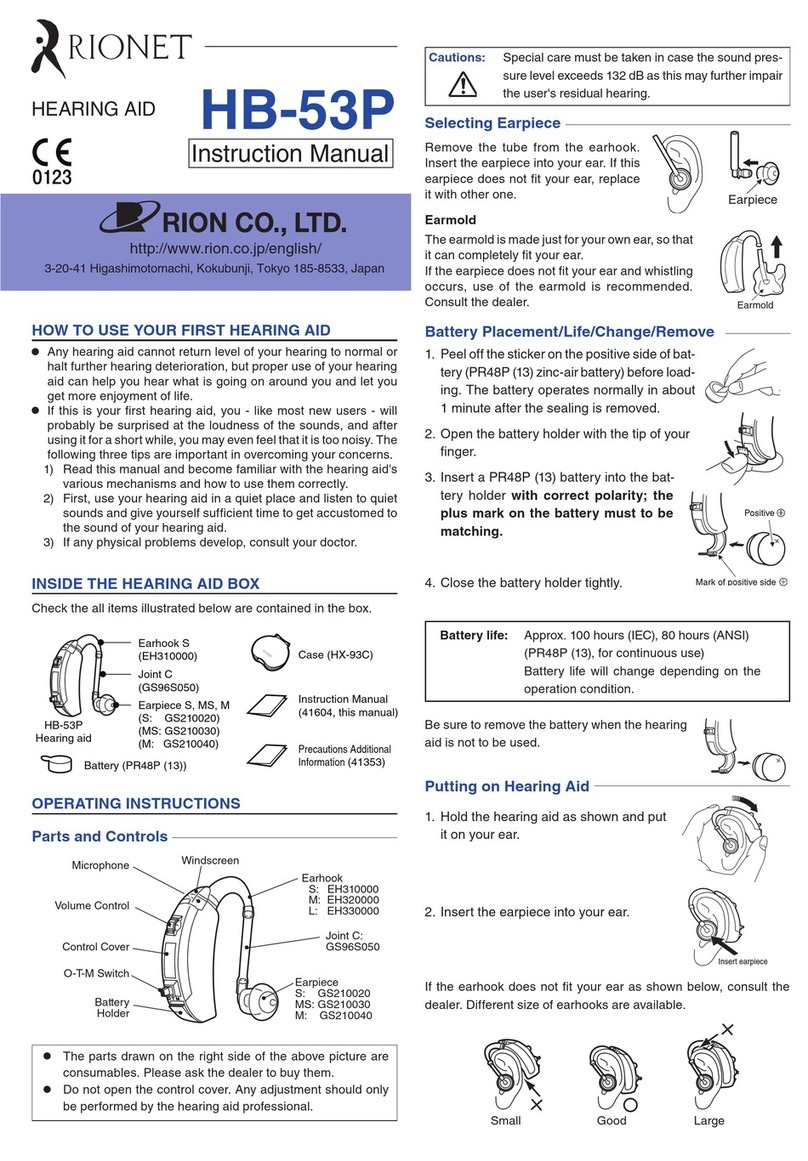
rionet
rionet HB-53P User manual
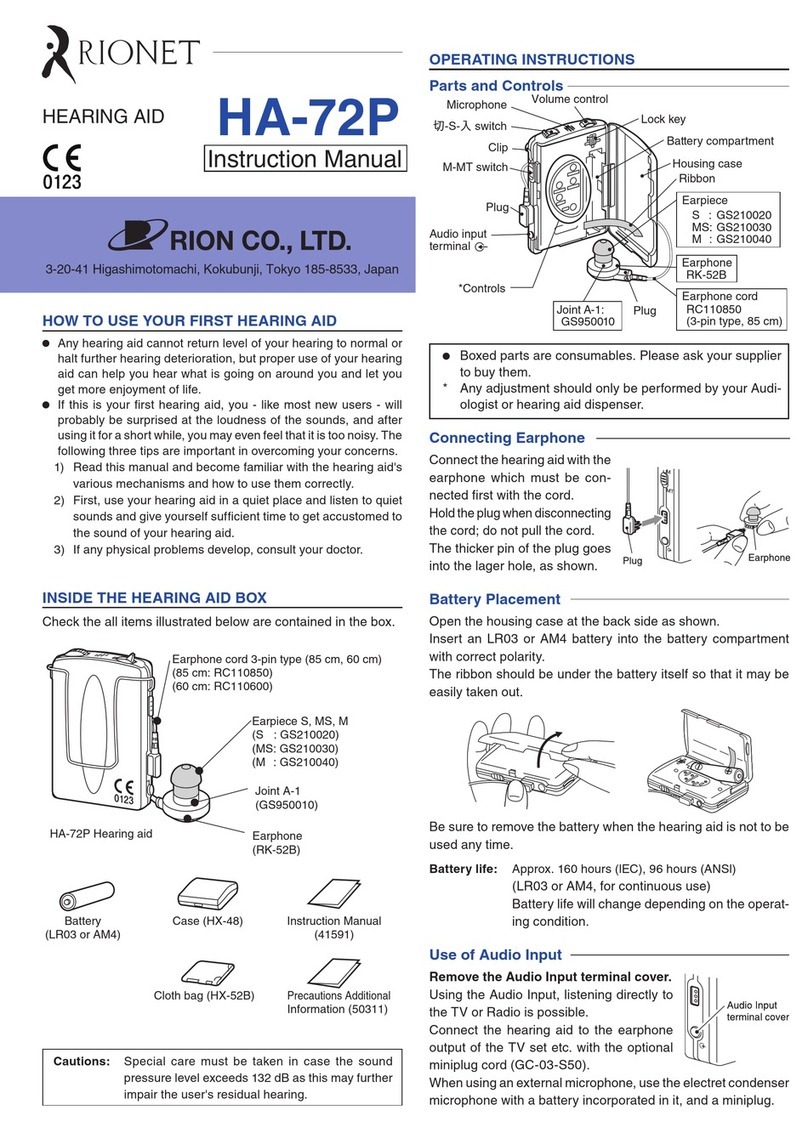
rionet
rionet HA-72P User manual
